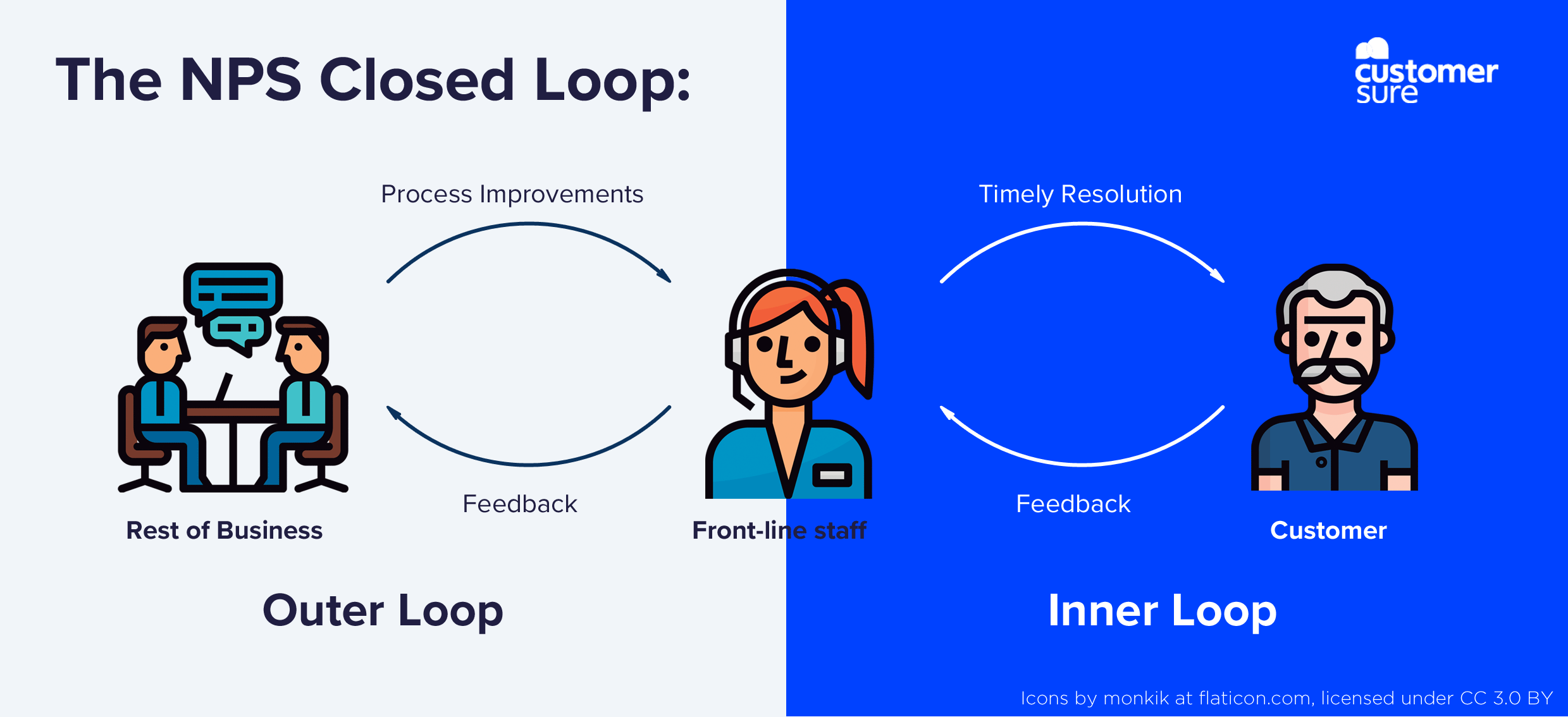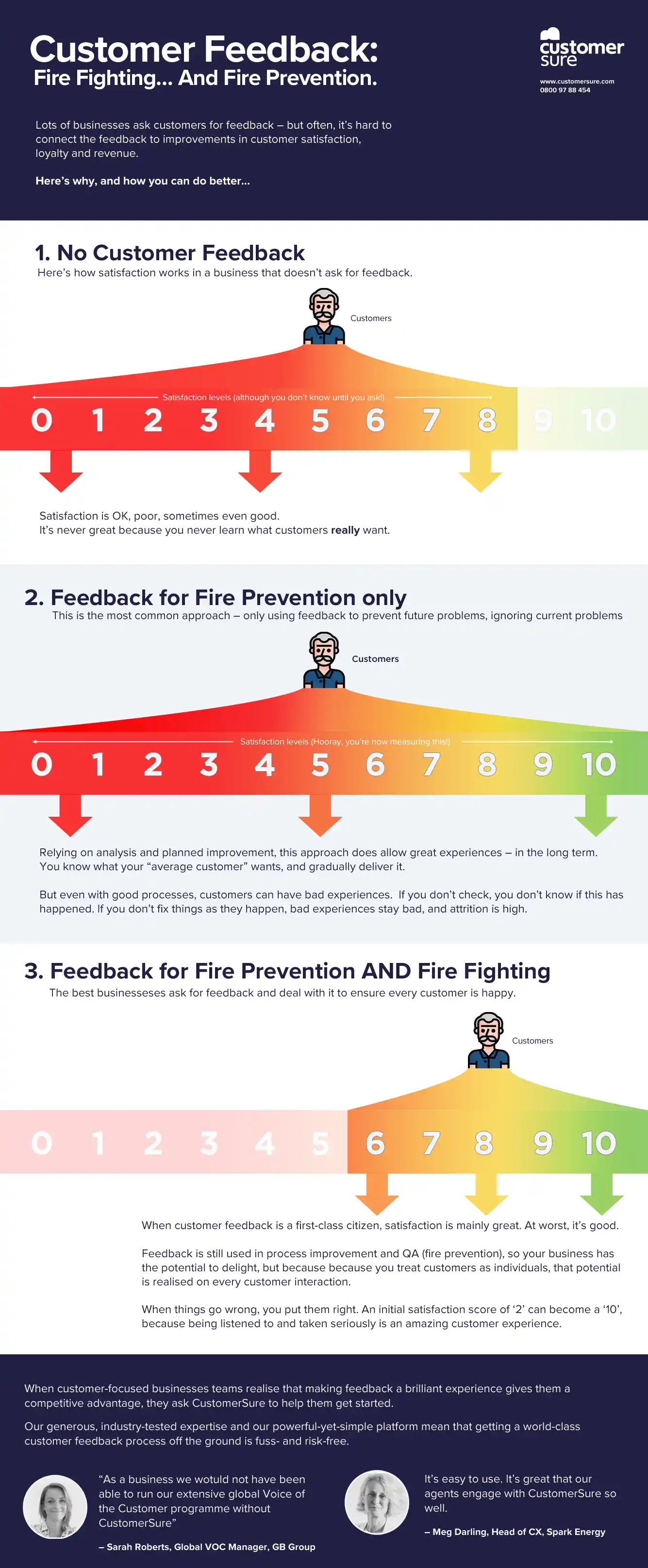

Many businesses don’t use customer feedback well – they see it as an input to process improvement and QA initiatives (So-called "Fire Prevention").
But sometimes a customer's poor experience is nothing to do with process design, so making the process better won't solve it – they need a quick resolution to an immediate issue. Businesses who can pick up on feedback and respond to it ("Fire Fighting") have happier staff, and happier customers who spend more.
Here’s why, and how you can get started…
In our last blog post, we explored one of the reasons why people resist doing customer feedback. You should read that post, but the short version is that customer-centric feedback surveys get melded with business-centric research surveys, and the results please neither customers nor business.
In this post we’re going to look at another misunderstanding which often trips people up when they start collecting feedback for the first time – how the feedback you collect gets used.
Throughout, we’ll use the analogy of stopping your home from burning down. To keep our houses intact, we all accept we need two things:
Fire prevention - building our houses out of safe materials, being careful with candles, and getting reputable electricians to check our wiring.
Firefighting – having a trained fire brigade on standby to respond quickly to any problems which occur despite our fire-safety efforts.
We understand that although prevention is important, we wouldn’t want to live in a world without firefighters, because prevention is never 100% effective.
It’s the same with customer satisfaction. You can try lots of different things to make sure customers have the best possible chance of a great experience with you:
But ultimately, if your goal is 100% satisfaction, you need a “fire brigade” for when things go wrong.
The only way to guarantee every customer is happy, every time is to ask them if they are happy, listen to what they tell you, and put things right if needed.
Let’s see how this plays out in practice:
Every business is here at some point. Some move on quickly, some stay here for years:

A business that doesn’t collect feedback can still be a really good business – either because of great people working there making a great effort to keep customers happy, or because their product/service is so fantastic that customers will put up with a lot to get it.
The problem is that this is all down to good fortune – the business works because it has great people working for it, or it’s in the right place at the right time, but this isn’t a safe position to grow a business from. It’s tricky to train new staff, and the business is at risk if key people leave or the marketplace changes.
One huge problem is that when customers have a bad experience, they have no way of getting issues resolved, so their frustrations can boil over. Minor gripes (i.e satisfaction scores of 4, 5, 6 or 7) can turn into complaints, or angry rants on social media.
At some point in the life of every business, the business decides it’s time to hear from its customers.
Things now usually look like this:

When most businesses start with feedback, they do so because they’re wanting to do research and analysis on it. Fire Prevention. They want to understand their “average customer” better, put in processes to support what most customers do most often, and train their staff to deal with common customer issues.
When you do this, the average satisfaction score does increase. When someone calls you, and they get a member of staff who’s having a good day, the computer system is working fine, and their request isn’t out of the ordinary, they will often score you a ‘9’ or ‘10’.
The problem with this approach, when used on its own, is it only raises your average highest scores.
It doesn’t prevent low scores.
Worse, you still run the risk of turning minor issues into full-blown complaints by not checking for customer happiness at the point of service, and rectifying problems when they happen.
We’ve looked at all the reasons that businesses take this approach in our guide to responding to feedback.
In a nutshell, talking to customers can be scary, so people avoid doing it!
But if a business wants to achieve brilliant customer satisfaction, and most importantly, be completely fair and honest with its customers – it needs to start listening and acting, not analysing and reporting.
It’s no good surveying all of your customers from January-March, taking two months to review the results, and planning some improvements to arrive in September to address the issues you identify. The unhappy customers from Q1 have switched to your competitors by Q3 and told their colleagues about their bad experience.
Market-leading businesses don’t just use feedback for fire prevention, they use it for fire fighting, and this is the result:

No customer is left behind.
Your fire prevention efforts drive up average scores, and your firefighting efforts pick up bad scores and turn them into good ones. Or they stop an average score becoming a terrible score.
Process improvement, QA and market research are all valuable, and they do unlock high satisfaction, but they don’t prevent bad experiences. Only a customer-centric feedback process does that.
At a high level, it’s not hard to start using feedback for fire fighting. You just need to:
(If you’re just getting started, absolutely do not get bogged down in your choice of scale or metric - they don’t matter as much as you might think).
And if your needs are complicated, or you’d just like a bit of reassurance that you’re doing the right thing – get in touch – we’d love to help you.
If you’re not entirely new to working with customer feedback, you might have heard of Net Promoter. In particular, we’re talking about the importance of closing both the inner and outer loop in your NPS.

If you’re thinking of starting to use feedback in your business, don’t fall into the trap of just using it for process improvement. You’ll see some benefits, but they pale in comparison to the benefits of genuinely listening to your customers.
Your team will thank you for making their lives easier, your customers will thank you (by sticking with you) for listening to them, and your boss will thank you for raising revenue.
Need help getting started? Why not ask us for a free action plan? Since 2010, we’ve helped mid-market firms build VoC programmes that get measurable results. We could do the same for you if you ask us!

Icons made by Freepik from www.flaticon.com, licensed by CC 3.0 BY.
Unlock actionable insights with our free, expert-crafted 3-Step action plan.
Discover more »Connect with a CX expert who’ll help determine your current VoC programme maturity level and provide a 3-step action plan to improve.